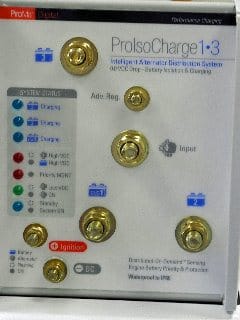
procharge2_001_5340.jpg
Over the weekend we received a query that should be shared with everyone. Here is John’s question:
“Hi Ed, Alden Trull put me on to your web site, very helpful fellow.I am re-wiring two boats at present, my own 42ft cruising ketch and a Farr 37 racing boat. Both have split battery systems for motor start and ship and I have a nav station on the other side to the present batteries (VHF, HF, Radar, Chratplotter & GPS)and I am considering a dedicated coms battery near to the stations to reduce volts drop. Present installation has a VSR between the start and ships battery and I’m not too confident in it’s its setting are out of my control. Considering diodes. What to you recommend? Will need solar and wind on mine eventually as she is on a swinging mooring in the Derwent River. I am in Hobart, Tasmania. I’m a Radio System Engineer (retired) so I understand the technology aspects. Regards John”
Today I see no reason to use diode type battery isolators when attempting to combine multiple battery banks. All of the vendors of DC equipment offer some sort of combining gear and the devices just keep on getting better. One good example fro Professional Mariner is shown here:

The ProIsoCharge 1-3 is a brand new offering fro ProMariner and I don’t have the exact specifications just yet but it looks to me like it offers the kind of functionality I typically look for in battery isolator/combiner devices, and could just be the ticket to take care of John’s needs.
The unit above is rated to work with an alternator with up to a 120 amp rating, which covers most all engine OEM installations. Its rated for ignition protection which is super important on gasoline fueled boats (petrol where John’s from).
I’ve got a call into ProMariner to get some additional specification info, but this unit appears to have pre-programmed outputs for both starting and house type batteries and it will handle one starter bank and two separate house banks. The box is totally waterproof to IP 66 standards too. The LED system monitor will indicate when each connected bank is in charge mode and provides warning indicators for both high and low voltage charging situations.
As for it’s advantage over traditional diode type isolators, well unlike those units this device does not induce voltage drop into the charging system like the diode types do. That in itself is a major advantage. Alden Trull BTW, is a fellow who created a wire sizing software program I’ve been using for years called Wire Sizer, which is in complete compliance with ABYC wire sizing standards. Wire Sizer is avaliable for download at Alden’s website:







